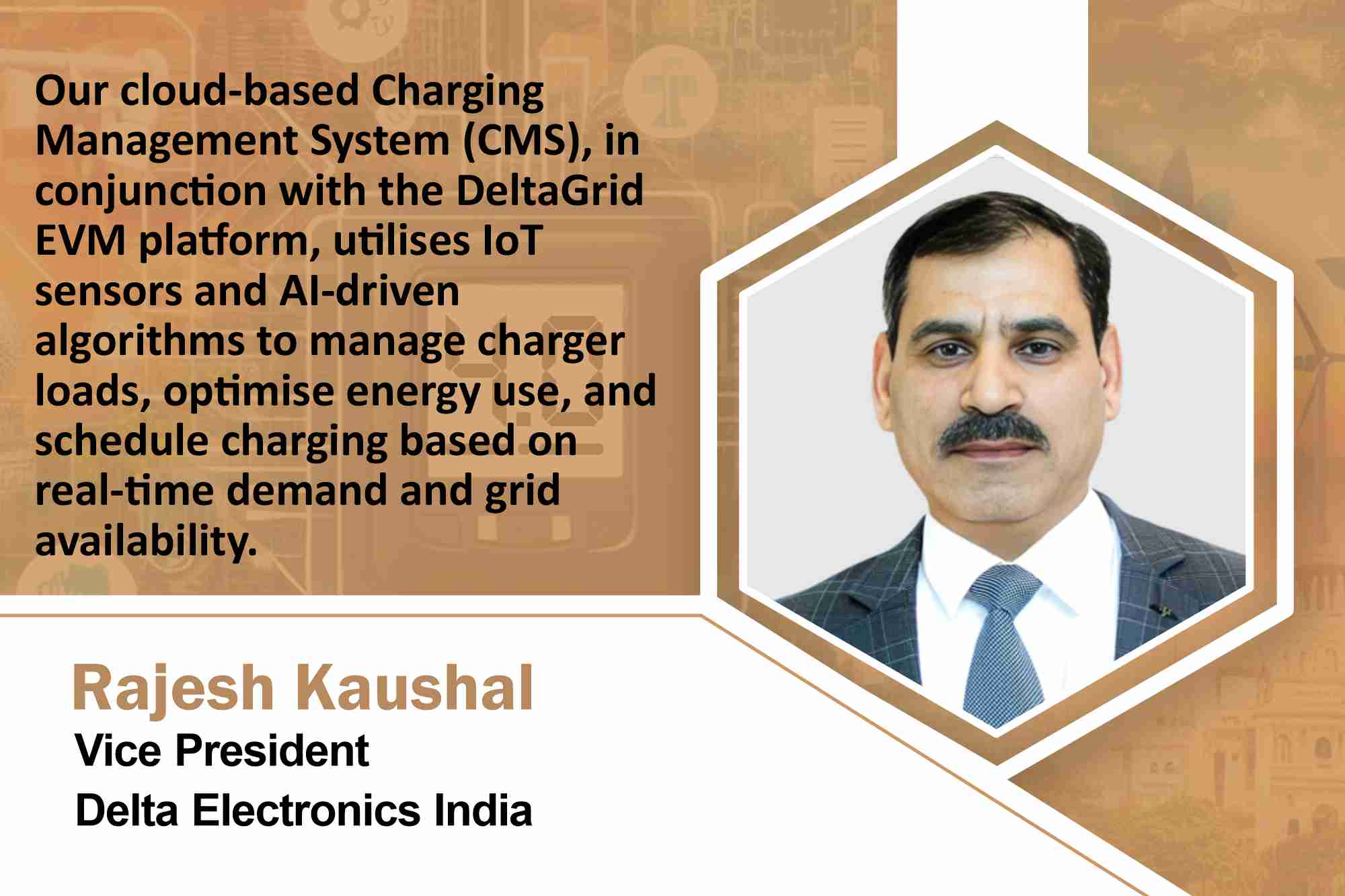DeltaGrid® EVM utilising AI, IoT to optimise charging and energy consumption
By Staff Report June 25, 2025 11:27 am IST
By Staff Report June 25, 2025 11:27 am IST

The RE2EV hub in Bengaluru combines solar, second-life batteries, and Delta DC chargers to function as a self-sufficient microgrid-powered charging station.
Delta Electronics India leverages smart grid integration to enhance load distribution, ensure power reliability and support demand-side management. Through hybrid charging systems that integrate solar PV, second-life battery storage and grid-tied infrastructure, the company’s highway charging stations can operate efficiently while reducing strain on the local grid. Additionally, advanced energy management platforms enable real-time monitoring and bi-directional energy flow (via V2G-ready systems), helping to stabilise the grid by feeding excess energy back during peak demand.
Rajesh Kaushal highlights the RE2EV hub in Bengaluru as a prime example of combining solar energy, second-life batteries, and Delta DC chargers to function as a self-sufficient microgrid-powered charging station. Let us hear from him.
How does Delta leverage AI and IoT to optimise performance in ultra-fast EV charging stations?
AI and IoT are integral to Delta’s smart charging infrastructure, providing critical capabilities for load balancing and real-time monitoring across ultra-fast electric vehicle (EV) charging stations. Our cloud-based Charging Management System (CMS), in conjunction with the DeltaGrid EVM platform, utilises IoT sensors and AI-driven algorithms to manage charger loads dynamically, optimise energy use, and schedule charging based on real-time demand and grid availability. These technologies detect inefficiencies, predict failures and reduce downtime by enabling remote diagnostics and automated maintenance workflows. AI also powers demand forecasting, which adjusts power delivery based on user patterns, vehicle types and time-of-day pricing. This digital backbone ensures that Delta charging stations, particularly high-capacity units such as 240 kW and 360 kW, can maintain optimal performance with minimal manual intervention.
How is your company ensuring grid-friendly and efficient energy distribution across its expanding electric vehicle (EV) charging network?
Delta is implementing several smart electricity strategies to ensure that energy distribution across the country’s expanding EV charging network remains efficient, sustainable, and grid-friendly. These include intelligent energy management systems (EMS) capable of dynamic load balancing, demand-response scheduling and renewable integration. Our charging infrastructure is designed to operate within hybrid microgrid environments, combining solar PV, second-life energy storage and DC fast chargers to reduce grid dependency. Chargers are modular and scalable, allowing operators to optimise installation based on real-time demand. We also support time-of-use and peak-shaving strategies aided by smart software that controls charging times and adapts to grid availability. These smart electricity strategies enable our network to handle high usage efficiently, particularly in urban areas and highway corridors where rapid adoption of electric vehicles (EVs) is occurring.How is Delta mitigating the grid stability challenges posed by the deployment of ultra-fast EV chargers in India?
The deployment of ultra-fast EV chargers introduces several challenges to grid stability, including peak load surges, voltage fluctuations and infrastructure inadequacies in semi-urban or rural areas. Delta Electronics India addresses these challenges through a multi-layered strategy. Our high-capacity chargers feature advanced thermal management, transient suppression and power conditioning technologies to mitigate electrical disturbances. We are also actively integrating battery energy storage systems (BESS) into our stations to buffer load spikes and manage energy more flexibly. Moreover, our chargers are designed for the country’s harsh grid environments, incorporating adaptive control systems that respond to power instability. Collaborative efforts with DISCOMs, urban planners and energy regulators are ongoing to ensure grid readiness and co-develop deployment frameworks. These measures are crucial to support the next wave of EV adoption without jeopardising power system integrity.
***************************
We use cookies to personalize your experience. By continuing to visit this website you agree to our Terms & Conditions, Privacy Policy and Cookie Policy.